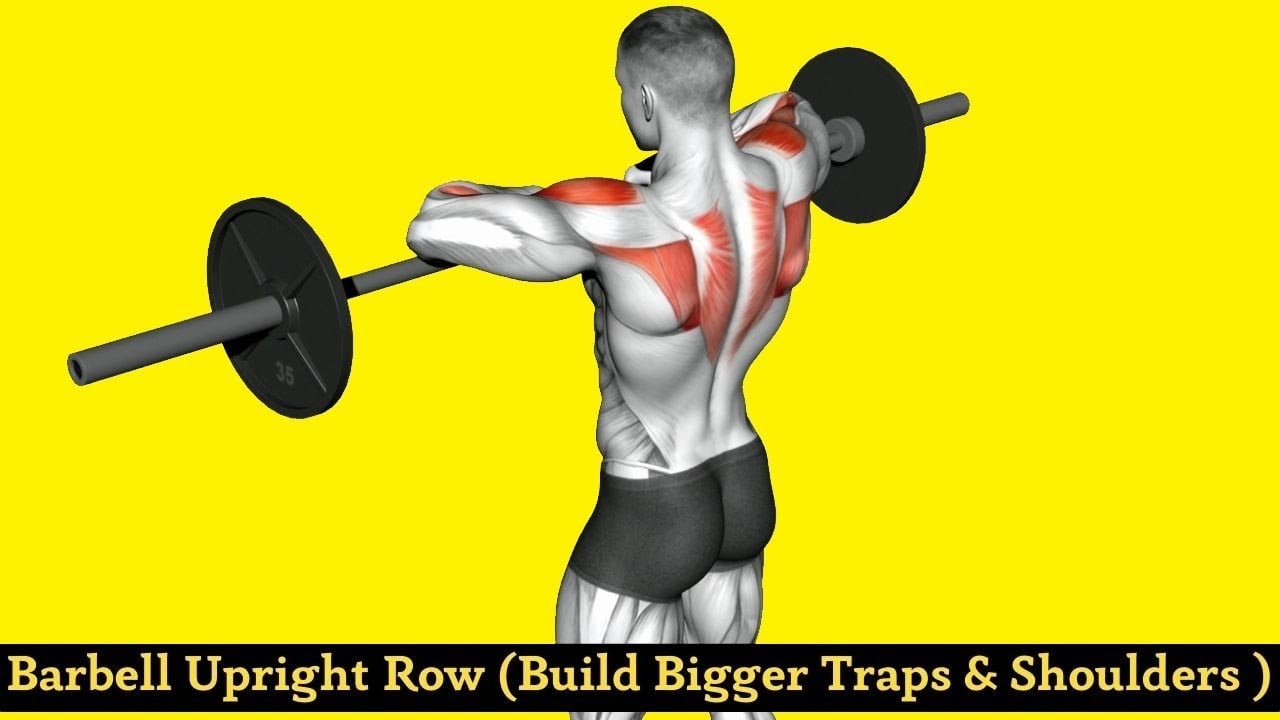The barbell upright row is one of the best exercises to build a stronger and bigger shoulder and upper back.
But it’s important to do it correctly to protect your shoulders.
Incorrect technique can prevent you from reaping the muscle-building benefits. And it also places undue pressure on your shoulders and increases your risk of injury.
Don’t be afraid to try it!
In this blog, we’ll break down the barbell upright row and show you how to master it safely for maximum gains.
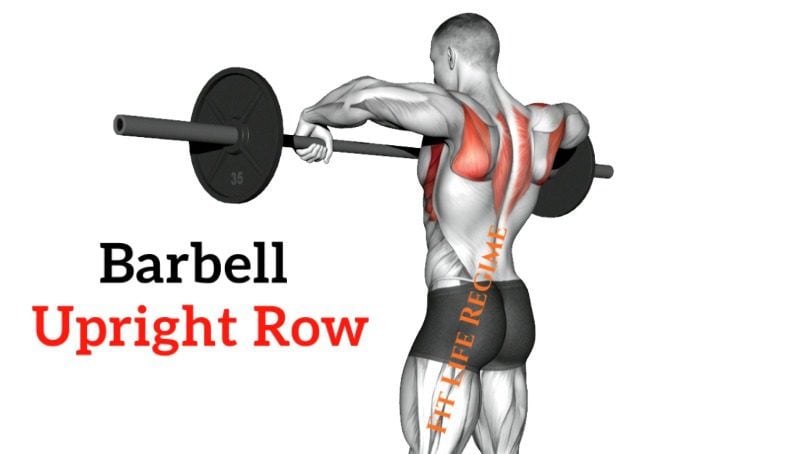
- What is Barbell Upright Row
- Muscle Worked During Barbell Upright Row
- How To Do Upright Row With Barbell
- Barbell Upright Row Form and Technique
- 1. Avoid Lifting Too Much Weight
- 2. Grip Position Best For You
- 3. Don’t Pull The Bar too high
- 4. Controlled Descent Motion
- 5. Avoid Swinging and Momentum
- 6. Keep The Bar Close To Body
- 7. Brace Your Core and Keep Your Torso Upright
- Barbell Upright Row Variations and Different Grip Positions
- 1. Wide Grip Barbell Upright Row
- 2. Close Grip Barbell Upright Row
- Barbell Upright Row Benefits
- FAQs
- Is the barbell upright row bad for your shoulders?
- How wide should my grip be for the barbell upright row?
- Are barbell upright rows good?
- Can you do upright rows with a straight bar?
- Takeaway
What is Barbell Upright Row
The barbell upright row is a compound exercise that targets the muscles of the shoulder and upper back, including the deltoids, trapezius, as well as the rhomboids, and even the biceps.
The exercise is named “barbell upright row” because the barbell is lifted up in a vertical, or upright, direction.
When done correctly, the bar upright row is a good exercise for building upper back and shoulder muscles. It can also help shape your arms.
Mastering the barbell upright row can help you with bigger lifts like bench press and deadlifts.
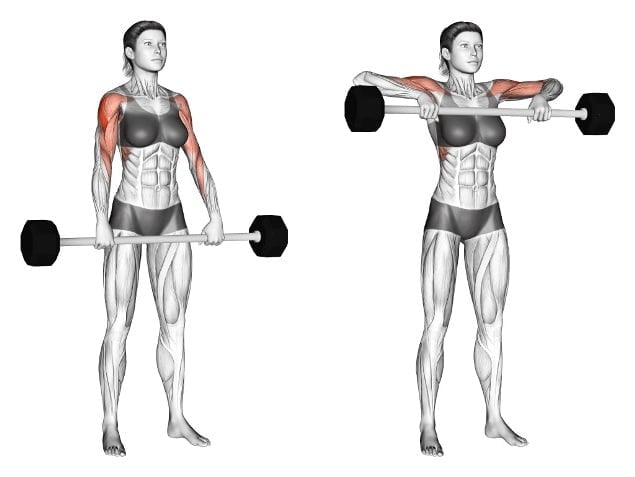
Want to take your gains to the next level? Discover your daily calorie needs with our free TDEE calculator.
Muscle Worked During Barbell Upright Row
Primary Muscles Worked during the upright barbell row are:
Secondary Muscles Worked during the barbell upright row are:
- Anterior Deltoid, Supraspinatus,
- Brachialis, Brachioradialis, Biceps Brachii,
- Middle and Lower Trapezius,
- Serratus Anterior,
- Teres Minor
A handful of other muscles worked or played the role of stabilizer muscles during the upright row, including yours,
- Wrist flexors,
- Obliques, and
- Rectus abdominis.

How To Do Upright Row With Barbell
- Stand up straight with your feet about hip-width apart.
- Hold a barbell with an overhand grip (palms facing your body).
- Your hands should be about shoulder-width apart or slightly narrower.
- Let the barbell hang in front of your thighs with your arms fully extended.
- Keep the barbell close to your body, exhale, and slowly lift it straight up towards your chin.
- Pause briefly at the top of the movement, then inhale and lower the barbell back down to the starting position.
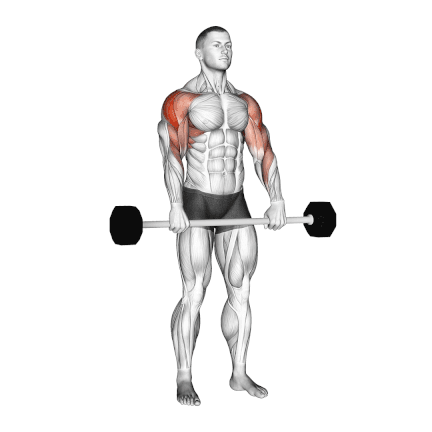
Barbell Upright Row Form and Technique
Following these points will help you maintain proper form and technique during the barbell upright row, which will ensure an effective and safe workout.
1. Avoid Lifting Too Much Weight
Always be careful when lifting heavy during the upright row, especially if you’re new to it. The shoulder joint is complex and vulnerable to improper form or excessive load injury.
Start with an empty barbell or very light weights. Focus on mastering the movement pattern first.
2. Grip Position Best For You
When it comes to barbell upright rows, your grip width matters – both for comfort and for getting the best results!
You might have heard that a shoulder-width grip is the standard way to do upright rows. And while that works for some folks, our shoulder joints have unique structures. What feels great for one person might cause pain for another.
So, it’s worth experimenting.
The best grip is the one that allows you to lift without pain and really feel the target muscles working. Notice which variation allows you to lift safely and seems to give your shoulders and traps the best workout.
3. Don’t Pull The Bar too high
One of the risks with barbell upright rows is going too high, which can increase the chance of shoulder impingement.
Remember, it’s about working your shoulders smartly, not just lifting the bar to the highest point possible.
Don’t lift your arms all the way up. Instead, stop when your elbows are at or slightly below shoulder level.
4. Controlled Descent Motion
While lifting the weight in an upright row is important, how you lower it matters, too. That lowering phase (called the eccentric) is super effective for stimulating muscle growth and strength.
But the key is control. Don’t just drop the barbell – actively guide it back down slowly.
Focus on a smooth, controlled movement throughout the entire exercise – both during the lifting and the lowering phase.
5. Avoid Swinging and Momentum
Don’t move around or turn around during the lift—just keep your body straight and your abs tight. Keep your back straight, your chest up, and your eyes focused ahead.
Don’t use your hips or legs to generate momentum that gets the weight up.
If you can’t lift the weight properly, reduce the weight you’re lifting.
6. Keep The Bar Close To Body
Avoid arcing the bar out from your body and keeping it close to you by raising your elbows up instead of out.
The bar should be closer to you so that all the muscles in your shoulder are working properly, including your side delts, which won’t get as much work done if you move it further away.
7. Brace Your Core and Keep Your Torso Upright
Just like with any other lift, a strong core is crucial for upright rows. It protects your spine by keeping everything stable and prevents you from swinging the weight.
Engage those abs throughout the entire movement! This protects your back and ensures you’re working the right muscles instead of relying on momentum.
Barbell Upright Row Variations and Different Grip Positions
There are different ways to do the barbell upright row. It depends on how you hold the barbell.
Barbell upright rows can be performed with three main variations of grip width:
- The close or narrow grip (half of shoulder width),
- A standard grip (shoulder-width grip)
- A wide grip (wider than the shoulder)
All have their unique advantages and disadvantages. Let’s take a closer look at each of these variations:
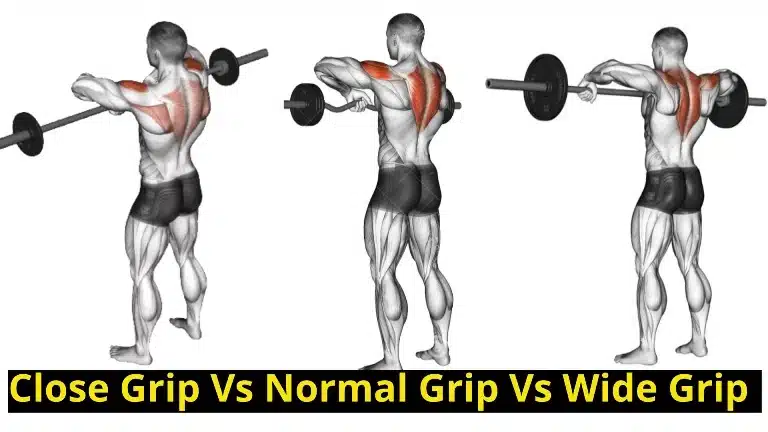
1. Wide Grip Barbell Upright Row
The wide-grip barbell upright row is preferable to the regular upright row because it prevents the elbows from going too high, preventing rotator cuff injuries.
The wide-grip upright row places heavy emphasis more in the lateral and rear deltoid and little lessor on the upper and middle trap.
Furthermore, the wider grip allows some cheating movement, thereby allowing you to lift more weight.
It may also be more shoulder-friendly for people who cannot handle the close-grip version.

How To Do It
- Hold a barbell with an overhand grip and stand hip-width apart with your feet hip-width apart.
- You should grip the barbell wider than your shoulders. Let it hang in front of you.
- Keep your barbell close to your body and lift it up to chest height.
- Pause at the top of the movement.
- Now, lower the bar under controlled motion until it returns to its starting position.
2. Close Grip Barbell Upright Row
The close grip upright row allows for maximum (Range of motion) ROM because it allows the elbows to raise higher than the shoulders.
The narrow grip upright barbell rows place emphasis more on the upper trap and a little less on the lateral delt and rear delt.
Many trainers recommend that you avoid the narrow grip upright row. They have come under scrutiny because they can harm your shoulders.
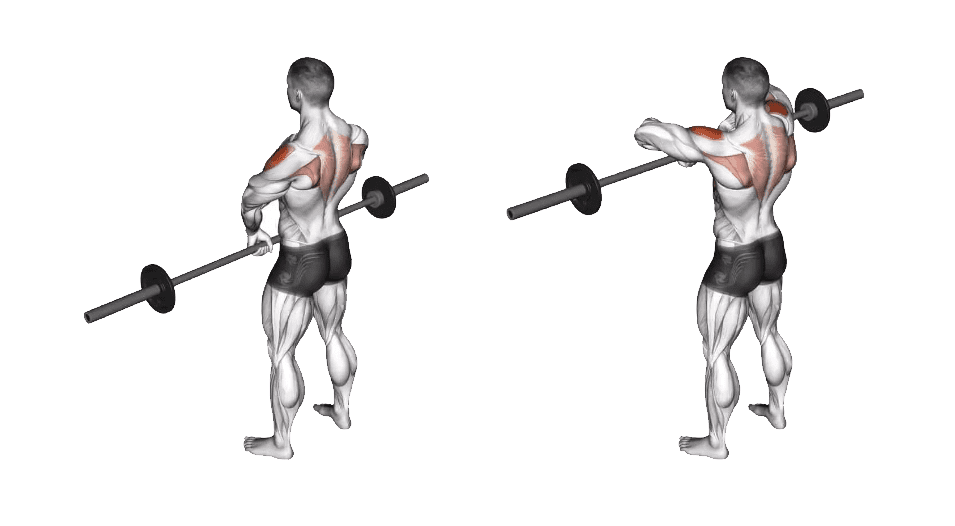
How To Do It
- Hold a barbell with an overhand grip.
- Your grip on the barbell should be less than shoulder-width apart. Let it hang in front of you.
- Keep your barbell close to your body and lift it up to chest height.
- Allow your shoulder blades to move naturally with your shoulder joints.
- Pause at the top of the movement.
- Now, slowly lower the bar until it returns to its starting position.
Barbell Upright Row Benefits
Here are the benefits of an upright barbell row :
- The barbell upright row intensely works a large group of upper body muscles, including your back, biceps, and shoulders.
- Research shows that the upright row is one of the best exercises for building shoulder strength and stability.
- Engages the trapezius muscles for a more muscular upper back.
- Improves strength in the rhomboids and other upper back muscles
- It also targets the smaller, stabilizing muscles of the shoulder joint, which are essential for proper shoulder function and injury prevention.
- In addition, strengthening the upper back and shoulder muscles may improve shoulder stability.
- Contributes to better posture and overall pulling power
FAQs
Is the barbell upright row bad for your shoulders?
The barbell upright row isn’t inherently bad, but it does carry a higher risk of shoulder impingement, especially if performed with incorrect form or excessive weight.
If you have shoulder issues, it might be best to choose alternative exercises targeting the same muscles more safely.
How wide should my grip be for the barbell upright row?
For most people, a shoulder-width grip is best for the barbell upright row.
But it depends on what you want to achieve. A wider grip can target the shoulders more, while a narrower grip can target the traps more.
Are barbell upright rows good?
Yes, barbell upright rows can be a good exercise for building shoulder and upper back strength. However, proper form is essential to avoid injuries.
If you’re new to the exercise or have shoulder concerns, start with light weights or choose alternative exercises that are easier on your joints.
Can you do upright rows with a straight bar?
The upright row is typically performed by holding a bar (EZ curl or straight bar) in front of you with a narrow, overhand grip and pulling it straight up to neck height, with the elbows leading the way and pointed up.
The straight bar upright row hits the delts, it builds the traps, and you see results fast.
Takeaway
The barbell upright row is a good way to build stronger shoulders, traps, and upper back muscles. However, it’s essential to remember the importance of proper form and careful weight selection.
Listen to your body! If you experience any shoulder pain, adjust your form, reduce the weight, or consider alternative exercises.
The goal is to build a stronger, healthier physique without risk of injury.
Thanks for reading.
References
- Schoenfeld, Brad MSc, CSCS; Kolber, Morey J PT, PhD, CSCS; Haimes, Jonathan E BS, CSCS: The Upright Row: Implications for Preventing Subacromial Impingement. Strength and Conditioning Journal: October 2011 – Volume 33 – Issue 5 – p 25-28
- Ronai, Peter MS, CSCS, RCEP: Exercise Modifications and Strategies to Enhance Shoulder Function. Strength and Conditioning Journal.
- McAllister M, Schilling B, Hammond K, Weiss L, Farney T. Effect of grip width on electromyographic activity during the upright row. J Strength Cond PMID: 22362088 DOI: 10.1519/JSC.0b013e31824f23ad
- Cools AM, Witvrouw EE, Declercq GA, Danneels LA, Cambier DC. Scapular muscle recruitment patterns: Trapezius muscle latency with and without impingement symptoms. Am J Sports Med 31: 542–549, 2003.
- Int J Environ Res Public Health. Trapezius muscle timing during selected shoulder rehabilitation exercises. 2021 Jun 14;18(12):6444. doi: 10.3390/ijerph18126444.PMID: 34198674
- Mazur LJ, Yetman RJ, Risser WL. Weight-training injuries. Common injuries and preventative methods. Sports Med 16: 57–63, 1993.

Manish is a NASM-certified fitness and nutrition coach with over 10 years of experience in weight lifting and fat loss fitness coaching. He specializes in gym-based training and has a lot of knowledge about exercise, lifting technique, biomechanics, and more.
Through “Fit Life Regime,” he generously shares the insights he’s gained over a decade in the field. His goal is to equip others with the knowledge to start their own fitness journey.

